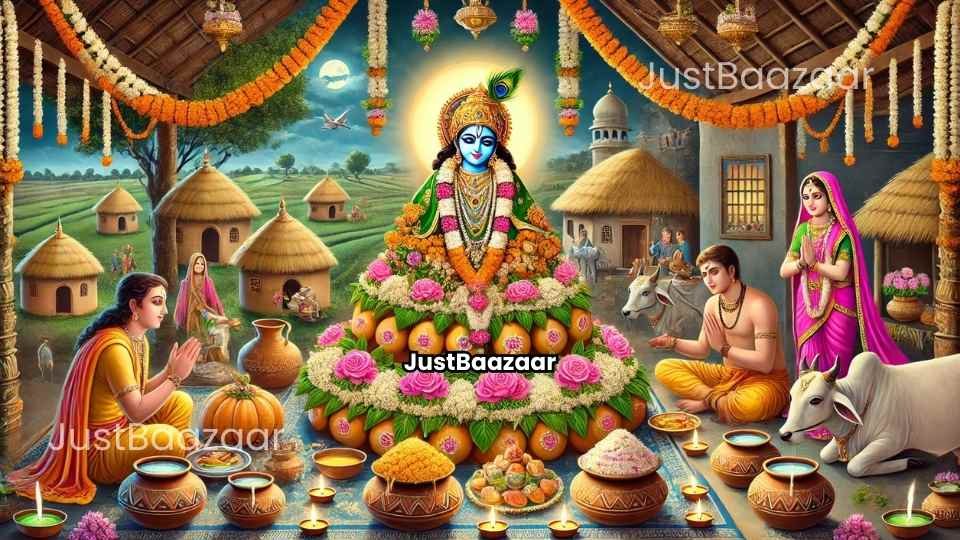Govardhan Puja, celebrated a day after Diwali, holds immense significance in the Hindu tradition. This festival commemorates Lord Krishna’s legendary victory over Indra, the god of rain and thunder, and his protection of the people of Gokul and Vrindavan. This festival is also known as Annakut (meaning “mountain of food”) due to the grand offerings made to Lord Krishna in gratitude for his divine intervention.
Govardhan Puja: History, Significance, Legends, and Cultural Anecdotes 🪔🌿

In this article, we will delve into the detailed history, stories, and importance of Govardhan Puja and explore the legends of Krishna, Indra, and the Gokul vasis (residents of Gokul).
1. The Origins of Govardhan Puja 🌿🪔
Govardhan Puja finds its roots in ancient Hindu texts, particularly the Srimad Bhagavatam, Vishnu Purana, and other sacred scriptures. The puja commemorates the story of Lord Krishna, who, as a young boy, lifted Mount Govardhan to shield his people and cattle from a torrential downpour caused by Indra’s wrath.
- Historical Context: The people of Gokul and Vrindavan were agricultural communities dependent on cattle and farming. Worshiping forces of nature, particularly rain gods like Indra, was an integral part of their lives. To appease Indra and ensure good rains for crops and cattle, the people used to perform an annual puja for the deity.
- Shift in Belief: Lord Krishna’s intervention symbolized a shift in the people’s belief system, urging them to respect nature rather than fearing the deities who control it. Instead of fearing Indra, Krishna taught them to find divinity in nature itself, represented by Mount Govardhan.
The origins of Govardhan Puja thus stand as a revolution in spiritual understanding, symbolizing the need to acknowledge, respect, and live in harmony with nature.
2. The Legend of Krishna, Indra, and Mount Govardhan 🌧️🪔
The legend associated with Govardhan Puja is one of the most celebrated stories in Hindu mythology, highlighting Lord Krishna’s wisdom and compassion for his devotees.
A. The Annual Ritual for Indra
According to tradition, the people of Gokul and Vrindavan would perform an elaborate ritual for Indra, the god of rain and thunder, to ensure sufficient rainfall and good harvests. This ritual involved grand feasts, offerings, and prayers to Indra, as rains were essential for their livelihood.
B. Krishna’s Intervention
Young Krishna, noticing the preparations, questioned his father Nanda Maharaj about the purpose of the rituals. Nanda Maharaj explained that the ritual was to appease Lord Indra, who would bless them with rain. Krishna, with his divine wisdom, suggested that instead of appeasing a powerful god out of fear, they should show gratitude to Mount Govardhan, as it provided them with food, shelter, and protection.
Krishna persuaded the villagers to abandon the ritual for Indra and instead worship Mount Govardhan, which nurtured their cattle and served as a natural shield for their village.
C. Indra’s Wrath and the Torrential Rain
Infuriated by the abandonment of his ritual, Indra unleashed a terrible storm over Gokul and Vrindavan. Thunder roared, lightning struck, and rain poured incessantly, threatening the lives of the villagers and their cattle. It was a time of utter chaos and fear, as the villagers sought a way to protect themselves from Indra’s wrath.
D. Krishna Lifts Mount Govardhan
To protect his devotees, Lord Krishna lifted Mount Govardhan on his little finger, creating a vast shelter under which the villagers and their cattle could safely stay dry. For seven continuous days, Krishna held the mountain aloft, without food or rest, as the people of Gokul praised his strength and devotion.
- Victory Over Ego: Seeing Krishna’s devotion and unwavering love for his people, Indra realized his own arrogance and sought forgiveness from Krishna. Indra bowed to Krishna, acknowledging him as the Supreme Being, and pledged never to misuse his powers again.
- Symbol of Protection: This act established Krishna as the protector of dharma (righteousness) and made Govardhan Puja a celebration of nature, humility, and divine love.
Since then, Govardhan Puja has been celebrated by creating small replicas of Mount Govardhan using cow dung and offering food in gratitude for Krishna’s protective intervention.
3. Significance of Govardhan Puja 🌸
Govardhan Puja is rich in meaning and symbolic of deep spiritual truths. It is a reminder of Krishna’s teachings on humility, the need for balance between humans and nature, and devotion.
A. Honoring Nature and the Earth
- Govardhan as a Natural Protector: Mount Govardhan is regarded as sacred in Sanatan Dharma, symbolizing the protective nature of the earth itself. The mountain provided sustenance and safety to the villagers, reminding devotees of the earth’s abundant blessings.
- Ecological Reverence: The puja emphasizes the importance of environmental protection and respect. Krishna encouraged his devotees to worship the mountain, highlighting that nature itself deserves reverence.
B. Lesson in Humility
- Ego vs. Compassion: Indra’s anger was rooted in ego, while Krishna’s intervention was rooted in compassion. Govardhan Puja teaches that humility and service to others are far greater than pride and power.
- Krishna’s Message to Humanity: By lifting Mount Govardhan, Krishna taught that one should not succumb to fear but, rather, place faith in goodness and compassion.
C. Strengthening Community Bonds
Govardhan Puja involves a community gathering to honor nature’s bounties. Families come together to prepare a grand feast, which is offered to Krishna and shared with others. This communal offering is known as Annakut, or “mountain of food,” representing gratitude for abundance.
4. Govardhan Puja Rituals and Customs 🪔🍛
Govardhan Puja is celebrated with unique rituals that honor both Lord Krishna and nature.
A. Preparing the Govardhan Replica
- In many homes and temples, small hills are made of cow dung to represent Mount Govardhan. These hills are decorated with flowers, kumkum, and images of Krishna to symbolize the divine shelter he provided.
- Devotees circumambulate these representations of Govardhan while singing bhajans (devotional songs) dedicated to Krishna, expressing gratitude for his protection.
B. The Grand Annakut Feast
- Annakut, meaning “mountain of food,” is a central element of Govardhan Puja. Devotees prepare a wide variety of dishes, such as sweets, fruits, vegetables, rice, and pulses, which are offered to Lord Krishna as a way of thanking him.
- The food is then distributed to family, friends, and community members, reinforcing the spirit of sharing and unity.
C. Parikrama of Govardhan Hill
- In Vrindavan and Mathura, thousands of devotees perform the Govardhan Parikrama, a pilgrimage that involves circumambulating the Govardhan Hill. This act of reverence reflects their respect for Krishna’s protective power and devotion.
5. Anecdotes and Regional Celebrations of Govardhan Puja 🌸
A. Govardhan Puja in Braj – A Festival of Grandeur
In Braj (Vrindavan and Mathura), where Krishna spent his childhood, Govardhan Puja is celebrated with immense devotion. Here, the Annakut feast is offered at the Govardhan Hill, where thousands of devotees gather to sing Krishna bhajans and perform Govardhan Parikrama.
B. Gujarat’s Annakut Tradition
In Gujarat, Govardhan Puja is part of the Diwali festivities. Thousands of devotees gather at the Swaminarayan temples and other Vaishnavite temples to witness a massive Annakut offering. The food offerings range from sweets to savory items, arranged in beautiful displays as a symbolic “mountain of food.”
C. Folk Dances and Songs
In rural India, especially in Uttar Pradesh, folk songs and dances are performed in honor of Krishna’s victory. These folk performances narrate the Govardhan story and spread messages about humility, courage, and environmental respect.
6. Importance of Govardhan Puja in Today’s World 🌍
Govardhan Puja’s teachings on environmental respect, humility, and divine protection hold great relevance today.
- Environmental Consciousness: The festival serves as a reminder of the sacredness of nature. As people face ecological issues, Govardhan Puja’s message of respecting and protecting nature is vital.
- Unity and Sharing: The Annakut offering promotes sharing and communal harmony, emphasizing that abundance is best enjoyed when shared.
- Humility Over Ego: Krishna’s victory over Indra underscores the importance of humility over pride, a valuable lesson for modern society’s pursuit of power and success.
In today’s world, where people often seek power, Govardhan Puja’s message encourages a humble approach to life, rooted in compassion, community, and respect for nature.
Conclusion
Govardhan Puja, celebrated in gratitude for Krishna’s divine protection, teaches valuable lessons on humility, the sacredness of nature, and the importance of community. It is a festival deeply rooted in Sanatan Dharma’s values, encouraging humans to live in harmony with nature and one another. Whether through the Annakut feast, the Govardhan Parikrama, or traditional rituals, the festival remains a beacon of devotion, ecological respect, and cultural heritage, serving as a timeless reminder of the wisdom Krishna imparted thousands of years ago.
Goverdhan Puja Wishes | Goverdhan Puja | Goverdhan Puja History |




